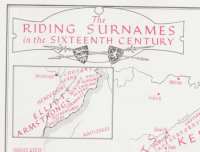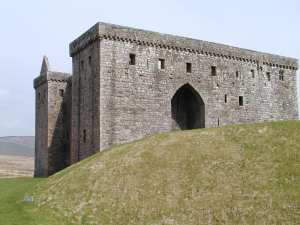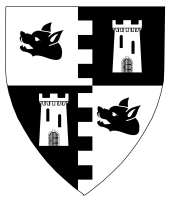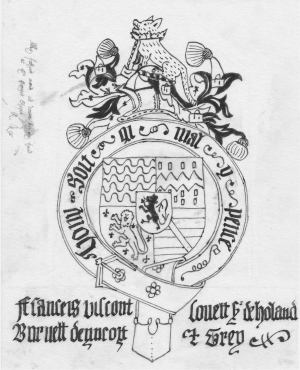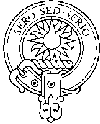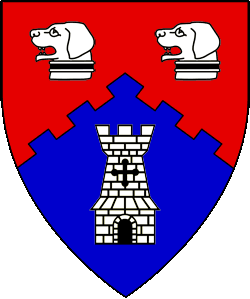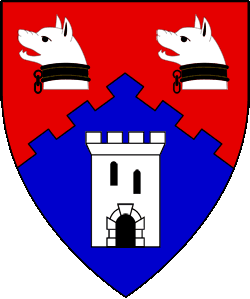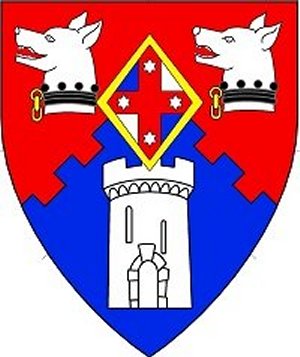 |
|
katherine kerr, her story[Story] [The Back Story: Francis Lovel] [Name] [Device] [My Mark and kk]Family Papers: [Introduction] [Patent of Arms] [Jousting Cheques] [Birthbrief] [Impresa] [Festival Book] [Family Tree from Heraldic Visitation] [Roll of Arms] [Armorial] I have lived as katherine kerr of the Hermitage for almost 20 years now. I'm still tinkering with her story, and it seems to get richer and richer by the day, though at the moment, my father's storyline seems to be developing at a faster pace! Katherine's story fuses my early interest in the House of York with my desire to base my persona on the Scots Borders. Story - A Tale of Old Lives and NewThe last hope of the Yorkist cause died on the field of Stoke, when my grandfather and many others gave of their best efforts to remove the Welsh usurper Henry Tydder from his ill-gotten throne. My grandfather left the rout of the battle, swam his horse across the Trent and headed north, as had his father before him, to rest up with relatives and friends across the Border. He knew that all was lost and was weary of the years of skulking and brief skirmishes that had been his lot since his liege lord and friend, Richard Plantagenet, had met his untimely death. He had thought to return to England, to take up the banner once more, but a long illness saw his strength sapped, and he became less and less inclined to carry on what now seemed a hopeless task. His disinclination became the stronger the more he was nursed by a Borderer lady, a cousin to the Middle March Warden. Finally he faced the distasteful thought that there was no longer a life in England for him. A new life began with his marriage to his erstwhile nurse, Anne Kerr. Because my grandfather still had powerful enemies of high rank in England, he took the name of the Border lady; it was not uncommon at that time for Scottish women to keep their own names after marriage. Francis Kerr, as he became known, was a quiet, rather melancholy man who often sat a-horse near the Border, staring southwards. He lived as a house knight at the Hermitage, the dour fortress buried in the depths of the Border dales. He spoke little of his life in England, and his son Richard, my father, grew up as a Borderer of Clan Kerr. Richard was the only fruit of the marriage and went to serve on the Continent in France and Italy as a sometime mercenary. While in Venice, he married a woman of the House Mocenigo (possibly attracted by the white rose that is the symbol of that family) and it was there that I was born in 1526. When I was 10, my mother died in childbed and my father brought me to Scotland where I was raised by my grandfather and grandmother. There I learned the tale of Francis Kerr and of our connections with the once-royal House of York. I grew up in the Hermitage, and have spent time in Edinburgh and Stirling. Last year, termed by some 1566, we saw a visit from the Lieutenant of the Borders, who had suffered a surfeit of Elliotts (as do we all!). Tongues were wagging over the lightning visit of Her Grace, Mary Queen of Scots, to the Hermitage to tend to the wounded Earl of Bothwell, Patrick Hepburn. No good would come of it....and then just see what happened in the cold days of February... I daresay whatever played out is long past, as these many years I have dwelt in the Laurel Kingdoms with my lord Bartholomew Baskin and our children Dickon, Pippin and Grace. Who knows how times moves between realms.... The Back Story: Francis LovelIn 1487, the battle of Stoke in the north of England saw the last major conflict of the Wars of the Roses. Francis, Viscount Lovel, was last seen alive at the height of battle, but his body was never found. One report had him drowned on trying to swim his horse across the River Trent, heading north for family lands and safety.In the 1700s, a secret room was found at Minster Lovell, wherein was discovered a skeleton, with a book and pen and a bottle. The family believed that they had discovered the whereabouts of their long-lost ancestor, although the skeleton's identity was never confirmed and the room was never seen again. It's likely to have been an apocryphal tale. So what did happen to Francis Lovel? In my story I contend that he headed across the Border, following the loss at Stoke, and stayed in Scotland. (A generation earlier, Francis Lovel's father had been one of the Lancastrian supporters to follow Margaret of Anjou into Scotland after the losses inflicted by Edward IV.) A recent communication indicates that I am not alone in making this suppostion! There are records that indicate Lovel went to Scotland from the Continent. In 1488, James IV, following a request from Margaret of Burgundy (Richard III's sister), provided safe conduct for him and 22 others to come into Scotland, according to Joe Ann Ricca, CEO/President of The Richard III Foundation, who thinks that the Pastons or Howards may have assisted Lovel (he'd had help from the Pastons previously). She also notes the existence of a record which states Brompton returned to England in 1492 and said he had seen (or been) with Lovell (pers.comm.) By 1488 Margaret was also in secret negotiations and correspondence with James IV of Scotland. On November 4th of that year...an embassy of 42 exiled Yorkists -- including Richard Harliston, a former govenor of Jersey, and the undrowned Lovell -- was sent by Margaret to see him. Safe conducts had been granted to both of them and, provisionally to "all other English persons whom they may draw to their cause. This comes from Wroe's Perkin, a story of deception (Vintage 2003), and she references RMS nos 1738 1798. The entries for James' reign start at nos 1731; Registrum Magni Sigilli Regum Scotorum 1424-1513 ed James Balfour Paul (Edinburgh 1884); see also Patrick Fraser Tyler History of Scotland (Edinburgh 1831) Vol 4 pp 371-372. Apparently Lovel's wife, Anne (or Anna) Fitzhugh, was conducting a search for Lovel as late as the 1490s and, at least at that stage, was not referring to herself as a widow. Anne is said to have died in 1512, but the source for that has other inaccuracies. Her search is mentioned by her mother, Alice Fitzhugh, in a letter to John Paston, provisionally dated 1488: "Also my doghtyr Lovell makith great sute and labour for my sone hir husbande". The letter goes on to state that "Sir Edward Franke hath bene in the North to inquire for hym [Lovel]; he is comyn agayne, and cane nogth understonde wher he is. Wherfore he benevolers willith hir to continue hir sute and labour; and so I can not departe nor leve hir as ye know well." Like many northern families, the Lovels had friends and relations across the Border. An early medieval motte built at Hawick (10 miles north of the Hermitage as the raven flies) is said to have been constructed by a Richard Lovell. The Lovels were said to have been rewarded during the reign of King David (1124-1153) with extensive lands in the Borders. They came north from their Somerset estate to make their headquarters in Hawick and were created first Barons of Hawick. They erected their wooden palisaded tower on a huge mound of upcast earth before a more substantial building took its place on the site of what later became the Tower Hotel and is now Drumlanrig's Tower Visitor Centre. (NB As far as I can figure, Lovell is a latter spelling variant, so I'm sticking to Lovel for Francis until told conclusively otherwise; Minster Lovell I'll retain as per the current place name's spelling.) In 1346, the lands were taken possession of by the English sheriff, following the capture of King David at the battle of Durham. The Lovels petitioned the English king to restore the lands and barony of Hawick. However the action of William Douglas delivered Teviotdale out of the hands of the English and by the end of the 14th century the lands passed into the family of Douglas of Drumlanrig. The display at Drumlanrig Tower says that in the early 1300s, at the time of Edward I (he died in 1307), the then-current Lovel abandoned his Hawick lands in favour of English ones. According to an updated entry on Stirnet, the Castle Cary Lovels (which include the Hawick line) and the Titchmarsh Lovells (which include Francis Lovell of Minster Lovell) were not related. More research is required... Stirnet shows Francis descending from Ascelin Gouel de Perceval (died before 1119), 'Lupus', Sire de Yvery or possibly Comte de Yvery (Ivry), and notes that Ascelin apparently gained the nickname Lupus (Wolf) because of his reputation for having a bad temper. This is also noted in the family tree information provided in St Kenelm's Church in Minster Lovell. Ascelin's second son William was nicknamed "Lupellus" (little wolf) or Lovel, and the name passed down as Lupel and thence Lovel. According to Taylor (pg 16), William was granted the land of Minster Lovell by Henry I in or after 1124. This line had Scottish connections. In 1296, John Lovel (the 1st Lord Lovel) was marshal of Edward I's army in Scotland, serving there again in 1303 and 1304. The keys of Stirling Castle were surrendered to him after a three-month seige, and his son (also called John) was killed at the battle of Bannockburn. Francis Lovel was the son of noted Lancastrian John Lovel, 8th Lord of Titchmarsh, Lord Holand (d 09/01/1464/5) and Joan Beaumont (d 05/08/1466), daughter of John Beaumont, 1st Viscount. Francis succeeded to his titles as a minor (being arounf 10 when his father died), and was brought up as a ward of Richard Neville, Earl of Warwick, in company with Richard Duke of Gloucester, later Richard III. Stirnet's listing, drawing from the TCP other sources, show Francis Lovel, as 9th Lord of Titchmarsh, Lord Holand, Viscount Lovel (b c1455, dsp 16/06/1487), and last of the Lovel's at Minster Lovell - the hall and grounds were given by Henry VII to Jasper Tudor in 1486. Francis was married to Anna FitzHugh (daughter of Henry FitzHugh, 6th Lord) and niece to Warwick. He had two sisters, Joane and Fridiswide. Francis Lovel is perhaps best known for his appearance in William Collyngebourne's scurrilous rhyme, repeated by Shakespeare, maligning Richard III and his supporters: The cat, the rat and Lovel, our dog One source quotes Lovel as having been referred to as "the King's Spaniel". He served Richard III as Chief Butler of all England, Privy Councillor, and Lord Chancellor of the King's Household, and became the 221st Knight of the Garter. His Garter Stall plate survives, and the hound is used in my device. According to Geoffrey Richardson's lecture The Henchmen, on June 20th 1480, Lovel was appointed a Commissioner of Array for the North Riding of Yorkshire. His first duties involved the recruitment of men to march with Gloucester on a major, punitive campaign into Scotland. Lovel found opportunities to distinguish himself in the ensuing fighting and he was knighted by Richard at Hutton-by-Berwick on August 22nd 1481. After the campaign, Richard continued to find employment for Lovel in the north and he was appointed a commissioner of oyer and terminer for Yorkshire in March 1482. NameKatherine"Katherine" derives from Greek (pure) and has been used in a variety of spellings throughout the period of the SCA, including in the 16th-century Scottish Borderlands. This variant is formally recorded as used in Scotland in 1512 [THOWLESS, 770]; 1542 [MACAUSLAN]; and 1564 [YESTER, 827] in "A List of Feminine Personal Names Found in Scottish Records: Part Three: Post-1400 Names" by Talan Gwynek. The citations in square brackets refer to the surname and page number which references this spelling of Katherine in George F. Black, "The Surnames of Scotland". "Katherine" is also referenced as being found for entries in the years 1551 and 1577 in Names of women mentioned in the Perth Guildry Book 1464-1598, a list by Aryanhwy merch Catmael based on the Perth Guildry Book 1452-1601 (ed Marion L. Stavert; Edinburgh: Scottish Record Society, New Series no. 19, 1993). "Katherine" is also listed by Sharon Krossa, in Early 16th Century Scottish Lowland Names Women's Given Names - Alphabetical, as having 46 instances in 16-century Scotland, with Katherine being the most common (17 citations), centred around 1548-49; also Katherin (6; 1509) and Catte (4; 1531). Krossa's listing, It is also the spelling that is most commonly cited for Richard III's bastard daughter, which fits my persona story nicely. Cathryn is my middle name mundanely. KerrThe Kerrs (Ker, Keir, Carr, Carre) were a large, infamous Border riding family for most of the 16th century, noted as a "leading tribe of the Middle March" (Fraser, pg 45). Reaney & Wilson cite Kerr as a Middle English name, with an early example being Robert Ker in 1231 (pg 84). Kerr family history has a tradition that they came to England in 1066 with de Bruys, ancester ot the Bruces. "Kerr", is also found in Black s.n."Ker", dated to 1357 and 1686 in this spelling.
According to Alistair William Jackson Kerr, the Kers are easily traceable to Eastern Brittany, specifically to St Brice en Cogles, near Fougères. They were originally gamekeepers to the feudal lords of St Brice, whose descendants, many generations later, became the Bruces. He says that couped stag's head in Kerr heraldry makes reference to this relationship. The Ragman Roll (a fealty roll of nobles and landowners prepared in 1326) lists four entries for Kerr/Ker/Kerre: Henry Kerr of Edinburghshire, Andrew Ker of Stirlingshire, Nicole Kerre of Peeblesshire and William Kerre of Ayrshire. A Charter under the Great Seal by Robert the Bruce cites Wilhielmi Ker, holding the 20 merk land of Kersland. It is said that two descendants of Kersland were involved in the murder of a laird and that they fled the area to found the Border Kerr clans (Ralph Kerr, Teviotdale 1330, later of Ferniehirst; John Ker, Cessford). Other spellings found in the 1500s include Kair and Kayr, noted in Early 16th Century Scottish Lowland Names Surnames - Alphabetical by Sharon L. Krossa. The Academy of Saint Gabriel gives the spellings Ker 1467; Carr 1491; Car 1515; Kere 1493; as well as Carre, Kar, Karre. (Report 2421) According to the Stirnet Genealogy Families Database (III - BRITISH FAMILIES - MEDIEVAL, RENAISSANCE & MODERN), the Kerr family is thought to be of Norse rather than Norman origin. The name is variously spelt Ker or Kerr and it is likely that various families named Carr are descended from this family. Stirnet, based on TSP and BP as well as family usage, tends to cite Ker for the senior line that led to the Earls & Dukes of Roxburghe (such as Cessford) and as Kerr for the branch that led to the Earls & Marquesses of Lothian (Ferniehirst). That said, I cannot find any period reference to the variation in spelling, and all the period sources I've consulted to date have Ker only.
It was nice to spot the name badge on the Historic Scotland chap at Linlithgow Castle. When I asked him if he was a Cessford Ker or Ferniehirst Kerr, he said the latter and noted his name was spelled the same as the current Marquis of Ferniehirst. A further appealing aspect of the Kerr name is its meaning. Reaney & Wilson say it means "dweller by the marsh or fenny copse" (pg 84). My birth name has the same meaning and my ancestral Scots sept of Dunlop refers to "a hill in a bog". Kerr may be related to the Norse term "kjarr", meaning "small wood", or (far less likely) Gaelic for left-handed "Céarr". The name lends itself to a cant in my device relating Kerr/cur to Lovell/hound. Andrew Kerr, in tracing the French connection, says that Ker in Old Breton means a castle or a stronghold (in Welsh or Brythonic it would be spelt caer, as in Caerlaverock, the Fortress of the Skylarks). In modern Breton it means a house with land attached. Ker is, for obvious reasons, a component of many place-names in Brittany, and so also of Breton surnames and titles of nobility, as in Kérouaille, Kergorlay and Kersaudy. It's been fun having another Kerr locally, though I managed to convince Duncan Kerr that he really should be from the Cessford branch, just to provide a nice point of difference. The Ferniehirst and Cessford branches didn't get on at all well in period, though the branches later united in marriage! Of the HermitageI have had to add "of the Hermitage" as a byname to differentiate my name from Katharine Kerr, the modern fantasy writer. I've been using the name in the SCA longer than the writer's books have been available in New Zealand, but its necessary under current College of Herald rules. Although bynames were reasonably common thing to do at this time and place, I can't find any evidence that it was something that a woman would do. According to Krossa's Scottish Names 101, personal bynames could be locative (that is, involving locations or places), with two forms of these being toponymic bynames (involving proper names of locations, which can include territorial such as indicating places held or owned by the person or their family) and topographic (involving descriptions of places rather than place names). "Of the Hermitage" is toponymic as it is the place where katherine lives, being a fortress situated on the Hermitage Water, near Newcastleton, in Roxburghshire in the Scottish Borders (National Grid Reference: Hermitage, Scottish Borders; NY497 960 79). It was first built in 1242, occupied by de Soulis, Douglas and Hepburn, amongst others, and still is (mostly) standing. Of course, having this as a byname implies more than just that I live there, it suggests that I am the land-owner, which I'm not. The usage of "the Hermitage" as a familiar term for the fortress is attested in the following period sources:
…they shall deliver to the King's highnes of Englond...the castell called the Hermitage with all the lordschipis and landes belonging to the same This is cited as being from a secret document between King Henry VII of England and Archibald Douglas, Earl of Angus, dated 1491 and quoted in the Introduction (pg 2) of Hermitage Castle, the official souvenir guide written by Nick Bridgland for Historic Scotland (1996 ISBN 903570 28 X). I wish Stirling to be Edinburgh, Glasgow to be the Hermitage and I the Earl of Bothwell as I lie here and then I doubt not that she [Mary Queen of Scots] would be quickly with me. This was penned by a miserable Darnley (aka Henry Stewart, Mary's second husband) in January 1567, lamenting the fact that his wife was paying more attention to the Earl of Bothwell than himself (some would say he was whiney for good reason, as Bothwell ended up being Mary's third husband!). Taken from Major-General R.H. Mahon, Mary Queen of Scots A Study of the Lennox Narrative", para VIII; (Cambridge University Press, 1924 pg 125); quoted in Caroline Bingham's Darnley A Life of Henry Stuart Lord Darnley Consort of Mary Queen of Scots (Phoenix Giant, 1997; pg 172) In addition to these references, "James Hepburn, Earl of Bothwell...in the mid 16th century strengthened 'Th' Armitage meanyng to Kepe it by force'", quote cited without specific attribution as part of a photo caption by Keith Durham in The Border Reivers (Osprey Publishing, 1995, pg 9). And Claud Nau (secretary to Mary Queen of Scots) wrote that "…her Majesty was both solicited and advised to pay him [the Earl of Bothwell] a visit at his house, called the Hermitage", as quoted in Mary Stuart's Scotland; the landscape, life and legends of Mary Queen of Scots, by David and Judy Steele (Crescent Books, 1987, pg 124), presumably quoted from Nau's The History of Mary Stewart from the Murder of Riccio until her flight into England. My persona belongs to the Ferniehirst branch, it being closely tied to the Liddesdale area in which the Hermitage is found. According to Fraser, Robert Kerr was Warden of the Middle Marches in 1511(pg 121), and another Robert Kerr was Deputy Keeper of Liddesdale in the 1590s (pg 276). StatusWell, my name was initially rejected for the following reasons:
So I did more research, actually cut back the documentation to the leanest, strongest bones and, very reluctantly, decided not to request authenticity. Ironically, it's the Society's rules regarding conflicting with a modern mundane name that forces me into a less period form (I think the byname would really only have applied to males). Laurel has passed my name (huzzah!), noting that the additional phrase means I don't conflict with "Katherine [sic] Kerr" (she may be well-known in some circles but her name gets mispelled all the time!). I have since had people tell me they thought I was either presumptuous or stupid to pick such a name, but I've been using it since before her books arrived in New Zealand in the mid-90s.... Since I started on my family papers project, I have become a lot more relaxed about the spelling of these names. That's a modern preoccupation forced upon us by SCA heraldic registration. I'm happy to try all sorts of variants on my name, as they had in period. Thus my father Richard is Rychard in some uses, Ker in others. Probably the only place in which I will use the SCA-mandated form will be any award scrolls I end up with; certainly I don't use the byname at all if I can help it. The DeviceDevice the First (well first to be formally submitted, that is)Per fess and per pale embattled argent and sable, in bend two boarhound's heads palewise couped close and in bend sinister two towers palewise, all counterchanged.
Per fess and per pale embattled argent and sable In his monograph for the Heraldry Society of Scotland, Findlater noted that one of the distinctive characteristics of Scottish heraldry was the significant number of arms composed of sable and argent, citing examples from Erskine, Cunningham, Maxwell, Sinclair, Armstrong, Balfour, Colville, Colquhoun and Haldane and Campbell - Armstrong and Maxwell had strong representation on the border. For me, the sable reflects the mourning for the lost House of York. in bend two boarhound's heads palewise couped close
Lovel's Garter Stall has what is described as "an irregular shaped plate of gilded copper bearing within the Garter a shield quarterly: 1, barry wavy gold and gules (for Lovel) ; 2, azure billety and a dance gold (for Deincourt); 3, azure fleury and a leopard rampant silver (for Holand) ; 4, Barry silver and azure a baston gules (for Grey of Rotherfield) ; an escutcheon of pretence silver a lion sable crowned gold (for Burnell). Above is a silver helm garnished gold, with deep purple mantle sown with gold locks and lined ermine, with blue, red and gold tassels, surmounted by the crest, a silver dog having about his neck a gold crown and chain, and sitting on an azure and gold torse" (from Francis Lovell, Lord of Longdendale).
One question has been whether the stall plate is period. According to the Acting Assistant Archivist of the St. George's Chapel Archives & Chapter Library, there are good grounds for considering the stall plate to be the original one dating from 1483/4. The main one relates to the fact that Francis Lovel was degraded from the Order in 1485 and never re-installed. When a Knight was degraded his stall plate was often, but not always, removed and thrown into the Windsor ditch. Once it had been removed a new stall plate only ever regained a place inside the Chapel if the Knight was reinstalled. This was the case with Thomas Howard, for example. (The only other reason for a degraded Knight to have a stall plate replaced is if an original stall plate has been found in the modern day, in which case it is an event that is recorded). Therefore the fact that the plate exists although Lovel was degraded indicates that it is the original that was never removed. Tamara notes that a recent heraldic study of the stall plates has discovered that Francis Lovel's is the earliest surviving example of an English knight's arms being encircled with the Garter emblem. Another nice resonance with the Scots use of clan badges. In English heraldry, a collar was often used to distinguish between a dog and a wolf. The history of the Lovel name behind this particular charge makes it appropriate that there is a degree of ambiguity (which presumably did not bother the period heralds when Francis Lovel had his arms painted on his Garter Stall plate…). In early 2010, I got a chance to take a close look at the plate, and the depiction of the dog's head that I used is very close to the original artwork. There's even a Douglas one next to it which also has pointy ears. The Garter King of Arms was kind enough to let me have a high-resolution image from the recent photo survey, and the drawing above was based on that. I chose to have the hounds' heads close-couped, as this is found in many of the blazons in period Scottish heraldic rolls. My original thought was to use a collar fleury-counter-fleury which references the collaring practice while retaining a reference to Scotland. I suspect the royal associations of the latter would make it presumptuous. in bend sinister two towers palewise The tower, of course, is a reference to the Hermitage border fortress. The Hermitage itself is described similarly in almost all references: sinister, solid, forbidding, squatting in the valley of Liddesdale, the "most blood-drenched of Scottish valleys". The Kerrs were Wardens of the Middle Marches and Keepers of Liddesdale throughout most of the 16th century. They were also well known for their series of peel towers. It is commonly said that, because of a preponderance of left-handers amongst the Kerrs, the staircases in their towers spiralled anticlockwise, opposite to that of everyone else, to give the kerr-handed an advantage. (Fraser, pg 39) But the Kerrs were aye-the deadliest foes My motto would have to be “Love All” as a cant on my persona’s grandfather’s name. It is also a reference to a line from All's Well that Ends Well (Act 1, Scene 1):
On a vaguely related aside, it is amusing to note that the Kerr clan crest is that of a sun in splendour, a symbol also strongly associated with the house of York.
I did try submitting this, which was a major step (previous efforts, one of which I even embroidered enthusiastically, if a tad over-optimistically, never made it that far, usually because something else took precedence). Initially there was some discussion as to whether the hound head I used is acceptable. College/SCA practice is to require a hound to have floppy ears, for some reason, so some have argued this can't be a dog, but must be a fox, a boar (!) or a wolf. I'm not sure where this requirement comes from - the hound I've used is certainly a period example. Neubecker and Brooke-Little, respectively of the International Academy of Heraldry and the Richmond Herald of Arms, state that "the boar hound is recognisable by its erect ears, the hunting dog by its drooping ones" (pg 120), so if that's a recognised period distinction, I should be able to have a hound with its ears upright. However...it turned out that "boar hound" is a 19th-century term, so the whole submission got bounced because I used the wrong term in trying to ensure that the pointy-eared nature of my dog was recognised as legitimate. If only I'd used cur.... Interestingly I have recently come across a CoH discussion, regarding registration of a dog on a device, which says that the "Zuricher Wappenrolle shows a dog...with short pointed ears and a short tail, for the family of Toggenburg. Pastoureau blazons this dog simply as a chien (or dog) in Traité d'Heraldique". And a dog variously described as an aland or alaunt, is described as "a short-eared mastiff". It's possible that these are strictly continental usages I guess, but the whole thing does seem a tad arbitrary. So the thing I wrestled with is do I really go on banging my head against the wall or just take the easy route and give the Heralds a bog-standard floppy-eared dog out of the PicDic, then simply ignore that in favour of my period hound for my own artwork. That easy way does have a certain appeal -- though I'm presuming that, as the only thing mentioned in the rejection, it's the only problem with the device, and that may not be a valid assumption! But there's a certain niggling sense of principle about those damned ears.... Device, the Second...and Third...and....May Crown Darton ASXLIII inspired me to have another go at developing a device. The plan was to put both fighter's and consort's arms on the list tree, so that gave me a push to have at it. That and the kind offer from Rowany's scribes to work on a set of AoA scrolls for all of us who'd been awarded arms under Caid but had never got a scroll (we weren't aware you had to ask for them!). That offer came with a deadline date, requiring a submission to be under way.... I'd decided, after having made a number of black and white standards, that the monochrome look no longer appealed to me. And that the red and blue York-derived colours I used on the Wars of the Roses standard really did look rather lovely. It also took me some time to get away from the idea that just because all my garb is green -- a deliberate point of difference for katherine -- that didn't mean I had to have vert on my device. So azure and gules, eh? That still left the problem of the apparent marshalling. Some playing around with possible layouts saw me start to think about using per chevron as a division of the field. Having a plain line probably wasn't going to work with the two colours, but a clearly delineated line might, so I retained the embattled approach (next best thing to a bordure which I'd have loved as a cant, but couldn't see how it could be managed at the large size required). The embattled as also a homage to Caid, in which I'd lived for many years even if only in the far-off Southern Reaches. That just left me with the dog head problem. How to make sure it couldn't be mistaken for a boar or a bat? Well, Lovel's crest shows a dog gorged of a crown, and I gather that that is one defining feature which separates the dogs from the wolves heraldically speaking. So why not simply gorge the dog with the crown as per the period example. Then Lord Ronan found another version of the Lovel crest in the British Library's Lovell Lectionary (Harley 7026). This heraldry is that of John, 5th Lord Lovell of Tichmarsh -- Francis Lovel was his great-great grandson in direct descent and last of that line. And the good thing about it was that the ears pointed forward, pointy yes, but at least having them pricked forward means they are less likely to be taken for a boar or a bat. So we modified the dog's head to suit, even though I still had a wistful hankering for the original Garter Stall Plate artwork. The result was rather pleasing, right up to the point where I found out that it would be highly presumptuous to have a charge involving a crown. At least not unless I had a suitable title to support its use.... So off came the crown and on went a collar. Then the collar colour had to change -- with a couped head, the collar now counted as a tertiary charge, so the colour-on-metal rule came to the fore (an argent dog can be collared with a crown or, but a head can't be). Ironically enough, I knew I was likely to qualify for a baronial coronet shortly after the submission deadline as i was stepping down as Baroness of Southron Gaard and a Court Barony was a typical gift of the Crown for that service. I couldn't presume though, so thought maybe I could resubmit at some point with a crown-collared dog if I really felt the need to. The tower was a little tricky. I didn't want the standard waisted tower -- that's commonly used in Southron Gaard arms and I've always drawn my tower as straight-sided, in the same way that the Hermitage is straight-sided. Learney's Scots Heraldry has relatively few examples of towers in it, despite it being a reasonably common charge. MacLeod of MacLeod had a castle, with a tower component on top, so that was used for the basic shape, as I wasn't sure if the Lindsay one I'd used before was period artwork. By this point I was running very very close to the deadline for submissions in order to go on the list for a Caidan AoA. Between that, and the fact that I still had a dog with pointy ears and no idea what to call it, I gave up any hope of submitting my preferred researched artwork and simply sent in the PicDic versions of the bog-standard talbot-dog and tower. Ugly, ugly, ugly, but far less likely to make any commenting herald twitch...I hoped.... So the final blazon read: Per chevron embattled Gules and Azure, two curs' heads couped Argent collared Sable and a tower Argent
In AS44 my arms finally passed, huzzah! And so now I have had fun applying my preferred heraldry to all manner of objects, from a full achievement of arms, an armorial roll and other heraldic materials in my family papers project, to an heraldic chair seat. More projects are planned. I feel badly compromised by the compromises I've had to make to try to meet what seem to be very very arbitrary rules and requirements for the most part. And, like many others, I believe that the whole approach to heraldry within the SCA is badly, badly flawed. That's a shame, as heraldry per se offers some of the greatest possibilities for art and pageantry and persona development, yet there are so many people who are turned off by its current operation in the SCA. Ironically enough, when I was doing the research for my family papers project, I came across a facsimile of various Scots rolls of arms. The artwork in it is truly appalling -- mullets of five and six on the same arms, very wonky chevrons, unbalanced saltires, cinquefoils used instead of mullets and truly the wierdest-ever unicorn you ever saw. Makes me feel better about my artwork, and even more convinced that the modern preoccupation with precision and exactitude is waaaay out of court. Later, when visiting Ferniehirst Castle, home of the Kerrs, I was amused to see that Dand Kerr's arms, carved above the entranceway, also had an error (when the curator mentioned it, I piped up and said "Yes, there's supposed to be a stag's head in base"; his head shot around, startled that some visiting antipodean should spot that. Well, after all, dear old Dand is my great-uncle, sort-of...). The Saga Continued
The years passed...and so did a revamp of the dog artwork which was more acceptably canine-like, even if less recognisable as the Lovell hound. (Many thanks to Fiora Vespucci for that important tweak.) That revamp came as part of bringing my arms up-to-date after stepping down as Baroness of Southron Gaard -- the awarding of a Court Barony allowed me to add a pearled coronet to the collar, in another step closer to the Lovell example. So now the blazon read: Per chevron embattled Gules and Azure, two curs' heads couped Argent each gorged of a pearled coronet Sable, attached thereto two chain links Or, and a tower Argent I confess to using a little artistic license and having a gold outline on the coronet collar on occasion. I did try adding a Canterbury Cross as an artistic element in the centre of the coronet, but that got bounced as too close to a strawberry and thus vaguely ducal. Having got that variant passed, I then had to go straight back to the heralds to register the Augmentation of Arms I had received from King Ariston and Queen Lilavati in AS51. So now my blazon reads: Per chevron embattled Gules and Azure, two curs' heads couped Argent each gorged of a pearled coronet Sable, attached thereto two chain links Or, and a tower Argent, for augmentation overall on a lozenge quarterly azure and argent, a cross gules charged with four mullets of six points argent within a bordure Or It's a bit of a mouthful, and meant I had to modify a lot of painted devices on all manner of kit, but I'm pleased with the augmentation's positioning. Technically I wanted it to read "for augmentation in honour overall" -- the pun appealed and the honour point was used in Scottish heraldry for just this sort of thing. But I'm just happy to finally have it settled in a form I mostly like. katherine kerr, her mark -- and why I use kk
Dost thou use to write thy name? Or hast thou a mark to thyself, like an honest plain-dealing man? On occasion, I use an informal sigil. This mark goes on all manner of things from embroidery to books, and I now have a batch of fired clay tokens with the sun in splendour on one side and my sigil on the other. I have used it to sign official correspondence as Baroness of Southron Gaard, which some Uncharitable Persons have suggested indicates that I am illiterate... However I've got documentation for literate women in early modern Scotland using both signatures and sigils, as well as signing their names with a lower-case letter, which I've been doing for years -- Mary Queen of Scots being but one famous example of this latter practice (signing herself marie throughout her life), and I have documentation for more such as Catherine of Aragon who signed herself katherine when she wrote her rather bloodthirsty note to Henry crowing about having the bloody sark of poor old James of Scotland. Oddly enough, the use of the lower case letter has sparked almost more comment than anything else I do, with people trying to correct my poor capitalisation. But there is method in my madness (honestly, there usually is), so there!
| |||||||||||||||||||||||||||||||||||||||||||||||||||||||||||||||
